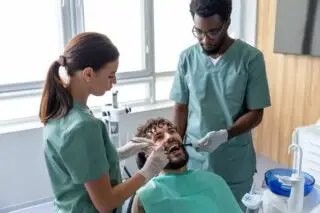
Updated: September 3, 2025
Our bodies are truly amazing. We can perform many types of motions, drawing on the intricate interplay of our bones, muscles, joints, and tendons to help us achieve both incredible athletic feats and simple, yet critical day-to-day maneuvers.
Qualities such as strength and flexibility drive these motions, helping us to adapt to various environments and physical demands as we go about our day. These essentials receive all the credit, but another element also deserves attention: range of motion.
As a measurable marker of movement, range of motion reveals how far various joints or body parts are capable of moving in specific directions.[1] This can be described as active or passive, with the former providing powerful insight into overall strength and coordination.[2]
Unfortunately, active range of motion (AROM) is a common deficit, especially following injuries, but also becomes more difficult to maintain with age. By actively seeking to expand AROM, we can preserve our physical function and overall comfort, boosting everything from athletic performance to quality of life.
Ready to improve your active range of motion? In this guide, we will help by explaining how to do an active range of motion exercises. We will also offer inspiration with detailed active range of motion exercises examples. Keep reading to gain the inspiration and encouragement you need to improve your range of motion.
Why Does Range of Motion Matter?
Range of motion has a huge impact on our quality of life, influencing every movement throughout the day. A strong range of motion facilitates seamless motions that feel natural and comfortable. The importance of this quality does not truly become apparent until it is lacking.[3]
With a limited range of motion, it becomes challenging to engage in everyday activities, including tasks such as dressing, cooking, typing, and even scrolling on smartphones. This, in turn, can limit independence and may also limit engagement in healthy living activities such as exercising. Those with a limited range of motion may also suffer considerable discomfort.
What Causes Limited Range of Motion?
Many factors can cause otherwise healthy individuals to suffer limited range of motion. While this problem naturally becomes more significant with age, it may also accompany specific concerns, often appearing in response to injuries such as fractures or sprains.
Range of motion may also become limited due to chronic conditions such as arthritis. Some people have a limited range of motion from the get-go. However, there are various structural concerns negatively impacting joint function. Initial limits in range of motion may spark a downward spiral, in which reduced movements lead to muscle weakness and further discomfort.
What Are Active Range of Motion Exercises?
The term “active range of motion” describes the ability to move a joint using one’s own muscles. This stands in stark contrast to passive range of motion (PROM), in which somebody else sparks movement. With AROM, the focus is not just on increasing flexibility, but also, on improving overall strength and stability.
How to Do Active Range of Motion Exercises
Many AROM exercises promise to dramatically improve the range of motion while also strengthening the muscles around affected joints. This expedites recovery while preventing further injuries and improving overall stability.
While each AROM exercise is performed differently, a few key principles always apply: maintaining slow, deliberate motions while breathing naturally and focusing on form. Above all else, avoid forcing any movements in a way that causes additional pain or discomfort.
Neck, Shoulder, and Elbow Exercises
AROM exercises are often associated with the lower body, but areas such as the neck, shoulders, and arms are equally important, as they play a central role in shaping our posture and facilitating motions like lifting or reaching. Top options for improving AROM in the upper body include:
Head Tilts and Turns
Head tilts are simple and effective maneuvers that can be performed in nearly any setting. These move the head in natural ways to engage critical muscles and joints in a pain-free manner.
Forward and Back
Also known as flexion and extension, forward-and-back motions involve looking toward the ceiling or bringing the chin toward the chest. Good postures and even breathing should be maintained throughout.
Side to Side
Qualifying as lateral flexion, side-to-side motions involve tilting the head toward one shoulder at a time, without actually lifting the shoulder. This can be thought of as bringing the ear to the shoulder.
Forearm Exercises
Exercises involving the forearm promote functional strength while helping to prevent the tightening of muscles that so frequently occurs following immobilization. Forearm supination, for example, involves the rotation of the arm, allowing the palm of the hand to face upwards or downwards.
Wrist flexion and extension involve bending the wrists up or down, ultimately improving grip strength while limiting pain associated with injury or arthritis.[4]
Hand and Finger Exercises
Range of motion is essential in the hands and wrists because these are so heavily involved in many of the day-to-day tasks we take for granted.[5] These include everything from writing and typing to cooking, gardening, and even playing musical instruments. Opportunities for improving AROM in the hands and fingers include:
Finger Bends and Spreads
Used for injury recovery and general arthritis relief, finger bends and spreads prevent stiffness in the finger joints while limiting swelling and supporting overall dexterity that plays into the many daily life activities mentioned above.
Finger bends begin with straight fingers, with each individual finger then bending at the biggest knuckle and then straightened fully. Finger spreads begin with the fingers placed close together, then opening and spreading as far as possible before bringing all the fingers back together again.
Thumb Touches and Stretches
Thumb touches provide an excellent warm-up, with the thumb gently touching each fingertip. This begins at the pointer finger and moves toward the pinky finger.
Other exercises can be supplemented by hard surfaces like tables or desks. With thumb extensions, for example, the palm is placed on the table, with the thumb then moved along the surface away from the pointer finger and toward it again.[6]
Thumb flexions are similar, but with the back of the hand on the table and the thumb moving across the palm toward the pinky finger.
Lower Body Active Range of Motion Exercises
Helping with joint stiffness after surgery along with circulation, balance, and general weakness, lower body AROM exercises focus on major joints and muscle groups, as described below:
Ankle Pops
This simple, but effective exercise involves flexing and extending the ankles. This fires up the muscles and can get many different areas working, making it an all-around great option not only for the legs, but also for the lower back and many other areas.
Heel Slides
Among the gentle AROM exercises for the lower body, heel slides can be performed while lying down. Begin with legs extended straight before slowly bending one knee by gliding the heel, keeping it in contact with the bed or floor. This should create a slight stretch in the hip. From there, slide the heel back down until the leg is straight.[7]
Abduction and Adduction of Hips
Abduction and adduction are distinct moves that address similar goals, consisting of boosting hip mobility and strength. Hip abduction involves moving the leg away from the body’s midline, often while lying on one side and lifting the free leg toward the ceiling.[8] Adduction occurs as one leg moves toward the opposing leg, usually while placing a ball or pillow between the legs.[9]
Long Arc Quads
Targeting the quadriceps, long arc quads (LAQs) are commonly used in physical therapy to build strength without placing stress on the knee. Begin by sitting upright, slowly straightening the knee (one leg at a time) until the entire leg is extended. The name “long arc” refers to the full range with which the knee is extended.[10]
Common Questions Around Range of Motion Exercises
Now that you know how to do active range of motion exercises, you may be wondering where or when to complete these moves. Below, we will provide answers to common questions, allowing you to start your AROM regimen with confidence. Get started by learning about our Physical Therapy Technology and Physical Therapist Assistant programs.
I Only Injured One Leg; Why Do These Exercises on Both?
Working just one side of the body can lead to significant muscle imbalances and uneven strength. Over time, this leads to a loss of muscle mass on the uninjured side, resulting in imbalances that negatively impact mechanics and increase the likelihood of future injuries.
How Do These Exercises Apply in a Hospital Setting?
While many people perform AROM exercises from the comfort of home, they are just as valuable in clinical settings and especially after surgery, limiting stiffness or discomfort after remaining in limited positions for extended periods. These may be guided by physical therapy assistants to ensure they’re performed correctly, thereby reducing the risk of injury.
Who Should Be Doing These Exercises?
Anyone can benefit from performing AROM exercises on a regular basis. These exercises are especially valuable for individuals who have suffered past injuries or are currently recovering from physical issues affecting the lower back, hips, knees, or ankles.
When Should We Do Them?
AROM exercises should be performed regularly to promote incremental, but consistent improvement. Over-training must be avoided, however, as this can increase the risk of injury. Morning exercises are often the most impactful, as the muscles may otherwise feel stiff following a full night of sleep.
Explore Physical Therapy Career Opportunities With Carrington College
As you bring healing and wellness to your own life, explore opportunities to help others achieve the same. Carrington College enables you to step into the roles of physical therapist assistant or physical therapy aide with programs designed to help you understand anatomy, physiology, and to use this knowledge to help patients.
Ready to make your mark in the inspiring world of physical therapy? Get started by learning more about our Physical Therapist Assistant and Physical Therapy Technology programs.
Sources:
[1] Physiopedia. “Range of Motion.” https://www.physio-pedia.com/Range_of_Motion
[2] Malacoff, J. “What Range of Motion Is—and How to Increase It.” The Healthy. https://www.thehealthy.com/exercise/range-of-motion/
[3] Sears, B. “What Is Range of Motion?” Verywell Health. https://www.verywellhealth.com/overview-range-of-motion-2696650
[4] Hersh, E. “About Wrist Flexion and Exercises to Help You Improve It.” Healthline. https://www.healthline.com/health/wrist-flexion
[5] American Society for Surgery of the Hand. “Hand and Finger Exercises.” https://www.assh.org/handcare/condition/hand-finger-exercises
[6] South Tees Hospitals. “Thumb AROM exercises.” National Health Service Foundation Trust. https://www.southtees.nhs.uk/wp-content/uploads/2021/12/MICB4472-Thumb-AROM.pdf
[7] Cronkleton, E. “How to Do Heel Slide Exercises.” Healthline. https://www.healthline.com/health/exercise-fitness/heel-slides
[8] Freutel, N. “The Benefits and Effectiveness of Hip Abduction Exercises.” Healthline. https://www.healthline.com/health/fitness-exercise/hip-abduction
[9] Preiato, D. “Hip Exercises for Building Adductor Strength and Preventing Injury.” Healthline. https://www.healthline.com/health/adductor-exercises
[10] New York-Presbyterian. “How To Do The Long-Arc Quad Exercise.” https://www.nyp.org/healthlibrary/multimedia/how-to-do-the-long-arc-quad-exercise



